Field Transmission of 100Gand Beyond:Multiple Baud Ratesand Mixed Line Rates Using Nyquist-WDMTechnology
Zhensheng Jia,Jianjun Yu,Hung-Chang Chien,Ze Dong,and Di Huo
(ZTE USA,Morristown,NJ 07960,USA)
Abstract In this paper,we describe successful joint experiments with Deutsche Telecom on long-haul transmission of 100G and beyond over standard single mode fiber(SSMF)and with in-line EDFA-only amplification.The transmission link consists of 8 nodes and 950 km installed SSMFin DT's optical infrastructure.Laboratory SSMFwas added for extended optical reach.The first field experiment involved transmission of 8×216.8 Gbit/s Nyquist-WDM signals over 1750 km with 21.6 d B average loss per span.Each channel,modulated by a 54.2 Gbaud PDM-CSRZ-QPSK signal,is on a 50 GHz grid,which produces a net spectral efficiency(SE)of 4 bit/s/Hz.We also describe mixed-data-rate transmission coexisting with 1T,400G,and 100G channels.The 400G channel uses four independent subcarriers modulated by 28 Gbaud PDM-QPSK signals.This yields a net SEof 4 bit/s/Hz,and 13 optically generated subcarriers from a single optical source are used in the 1T channel with 25 Gbaud PDM-QPSK modulation.The 100G signal uses real-time coherent PDM-QPSK transponder with 15%overhead of soft-decision forward-error correction(SD-FEC).The digital post filter and 1-bit maximum-likelihood sequence estimation(MLSE)are introduced at the receiver DSPto suppress noise,linear crosstalk,and filtering effects.Our results show that future 400G and 1Tchannels that use Nyquist WDM can transmit over long-haul distances with higher SEand using the same QPSK format.
Keyw ords coherent detection;field trial;coherent optical OFDM;Nyquist WDM;MLSE
1 Introduction
T he demand for bandwidth is being driven by more and more video streaming and proliferation of cloud computing,social media,and mobile data delivery[1]-[4].Along with the need for reduced cost per bit per hertz,this trend has led to high-speed underlying optical transmission interfaces.At present,100 Gbit/s long-haul systems,whether being developed or deployed,are all based on a single-carrier polarization-division multiplexed quadrature phase-shift keying(PDM-QPSK)modulation format that is associated with coherent detection and digital signal processing(DSP)[5]-[6].Spectral efficiency(SE)over a conventional50 GHz optical grid is 2 bit/s/Hz;thus,the system capacity is around 10 Tbit/s in a fiber C-band transmission window.Corresponding standardization for client-side 100GE,transport layer optical transport unit 4(OTU4),and key electro-mechanical aspects has been completed to make end-to-end system connection and interoperability possible[7].
Opticaltransmission at 100G+per channel is the logical next step to sustaining future traffic growth.Much research has been done on trading off capacity,data rate,and optical reach (Fig.1)[8]-[9].Optical time-division multiplexing(OTDM)is one of the classic approaches to increasing the channel data rate.A recent experiment with OTDM resulted in a symbol rate of 1.28 Tbaud and a single-channel bit rate of 10.2 Tbit/s with return-to-zero(RZ)modulation[10].Another recent experiment with OTDM resulted in 640 Gbaud and a line rate of 1.28 Tbit/s with non-return-to-zero(NRZ)modulation[11].However,the commercial reality is that OTDM provides limited system stability and compactness and is generally considered a useful interim technique to explore the limits of high-bit-rate transmission.It was replaced by electrical time-division multiplexing(ETDM)when the bandwidth of optoelectronic components allowed the desired bit-rate.Spatial-division multiplexing(SDM)that uses multicore fiber(MCF)or few-mode fiber(FMF)coupled with multiple-input multiple-output(MIMO)signalprocessing is being investigated.With recent advances in the fabrication of special fiber and in transmission performance,SDM shows promise[12]-[14].However,as well as design and manufacturing challenges,there are other significant challenges—such as fan in/out devices,connector/splice,and amplifier and transceiver integration—that show there is still long way to go before SDM becomes a commercial reality.

▲Figure 1.Research directions of scaling channelcapacity beyond 100G.
There are three main ways to increase channel bit rate when PDM and coherent detection are being used.The first way is ETDM,which increases symbol rate so that full advantage can be taken of mature electronic technologies(Fig.1).Using differential phase-shift keying(DPSK),symbol rates of up to 40 Gbaud have been achieved in field deployments[15],and using NRZ,a symbol rate of 100 Gbaud has been achieved in experimental conditions[16].Both these scenarios involve direct detection.With 30 Gbaud symbol rate,today's 100 Gbit/s commercial systems or 400 Gbit/s dual-carrier prototypes are limited in their ability to transport QPSKor 16 quadrature amplitude modulation(16-QAM)signals in coherent detection[17].In the laboratory,16-QAM signals with symbol rates of up to 56 Gbaud have been reported,but this comes at the expense of reduced transmission distance[18].
The second way is to use higher-level QAM formats because they provide higher SEthan PDM-QPSK,but this comes at the expense of higher implementation penalty,a higher requirement for receiver sensitivity,and reduced opticalreach.The required optical signal-to-noise ratio(OSNR)of a 16-QAM signal is 6 d B larger than that of a QPSK signal and grows exponentially as the constellation points increase(Fig.2)[22].In a recent laboratory experiment,the implementation penalty for a 16-QAM signal with BER=10-3was as great as 8 d B compared to around 1 d B for a QPSK signal[18].In a field experiment,512 Gbit/s dual-carrier 16-QAM signals were transmitted over a limited distance of 734 km.Dispersion-compensated standard single-mode fiber(SSMF)were used with 10 Gbit/s neighbors on a 200 GHz grid[17].These experiments prove how challenging it is to increase SEwith a 16-QAM format.
The third way is to use multiple optical carriers(superchannels)to overcome the speed and bandwidth limitations of optoelectronic components.These superchannels are ultra-densely packed 100-200 Gbit/s channels.So far,the transmission reach achievable using a single,high-SEPDM-QPSK superchannel is 7200 km[23],which implies that QPSK constellations reflect a good trade-off between SEand distance.As opposed to using single-carrier transmission in each channel,using multicarrier transmission requires a shift from fixed spacing grids to flexible spacing grids in opticalnodes.Among different multicarrier technologies,no-guard-interval coherent optical orthogonal frequency-division multiplexing(NGI-CO-OFDM)and Nyquist wavelength-division multiplexing(Nyquist WDM)have the greatest potential for higher SEwithout sacrificing too much transmission distance[24],[25].Comparisons of the time and frequency domains of the two technologies are shown in Fig.3(a)and(b).The basic idea of NGI-CO-OFDM is that the subcarrier spacing is equal to the baud rate in the frequency domain,and in Nyquist WDM,the subcarriers are spectrally shaped so that their occupancy is close or equal to the Nyquist limit for transmission that is free of intersymbol interference(ISI).The spectra of the optical subcarriers overlap,but the signals remain separable after optical detection because of their orthogonality in NGI-CO-OFDM.The need for higher sampling speed and bandwidth of the analog-to-digital converter(ADC)is also a challenge in demultiplexing[23].In Nyquist WDM,spectral shaping at the transmitter(Tx)is needed using either a specific optical filter in optical domain or Tx DSPwith digital-to-analog converter(DAC)in electrical domain.Nyquist WDM and NGI-CO-OFDM have been theoretically and experimentally compared in[26]and[27].The results show that Nyquist WDM is much more robust and practical in terms of ICI tolerance and implementation constraints.
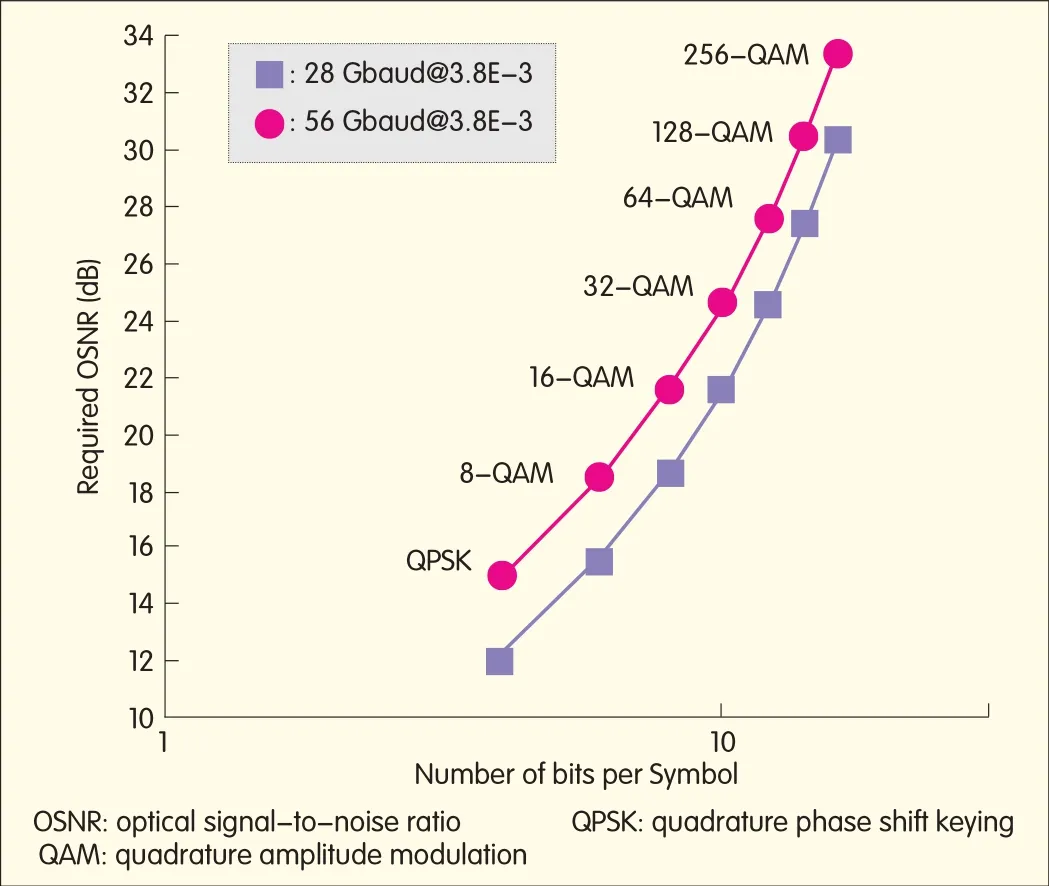
▲Figure 2.Challenges in increasing constellation points and baud rate.
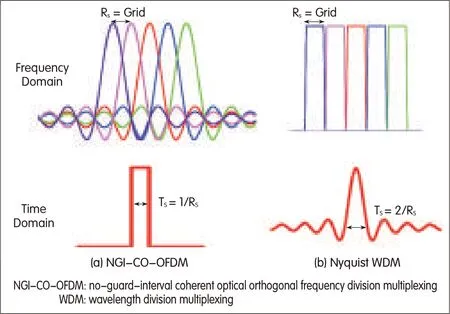
▲Figure 3.Multicarrier superchannelrealization using(a)NGI-CO-OFDMand(b)Nyquist-WDM.
Many laboratory experiments have been done on different system configurations with varying technologies.These technologies include electrical OFDM[28],[29]and optical OFDM[30]based on fast Fourier transform(FFT)and inverse fast Fourier transform(IFFT).The electrical OFDM has a single optical carrier with electrical OFDM signal modulation,and the optical OFDM has optical IFFTat Tx and FFTat Rx.Other technologies include electrical-optical OFDM with multiple optical carriers and electrical OFDM signal modulation[31],coherent WDM[32],and maximum a posteriori(MAP)or maximum likelihood sequence estimation(MLSE)algorithm for strong filtering and equalization of ISI[33].The factors that determine which technology is adopted include SE,nonlinear tolerance,cost,and integration compactness.
Although many experiments are adequate for proof-of-concept,field trials impose more rigorous and realistic requirements on the system and are much closer to real implementation.For example,the system must automatically adjust to changes in chromatic dispersion(CD)and polarization-mode dispersion(PMD)caused by temperature and mechanical disturbance in different locations.Other unknown factors also affect the performance of blind equalization at the receiver.Operators need to characterize different technologies in order to better understand system-level implications of latest approaches for a real fiber network.In the past three years,there several field trials have been done to test and evaluate commercial 100G and beyond optical systems.In 2010,ATamp;Tassessed the feasibility of upgrading their network with a 100G channel over 1800 km with dispersion compensation module(DCM)and neighboring 10G and 40G DWDM systems[34].In 2012,they then successfully demonstrated 3760 km transmission of a 1100G channel with soft-decision forward-error correction(SD-FEC)over uncompensated 40G-optimized DWDM reconfigurable optical add-drop multiplexing(ROADM)systems for 80 km SSMFspans[35].Verizon completed the first trialof end-to-end native IP 100G single-carrier coherent detection transmission over 1520 km.100GErouter cards and 100GBASE-LR4 C form-factor pluggable(CFP)interfaces were used[7].They performed the first mixed-channel(112 Gbit/s,450 Gbit/s,and 1.15 Tbit/s)transmission based on coherent OFDM with spectral efficiency of up to 3.3 bits/s/Hz[36],and they also achieved the highest capacity in a field trial:21.7 Tbit/s with 8-QAM and QPSK[37].Deutsche Telekom conducted a field experiment on 253 Gbit/s electrical OFDM channels over 764 km SSMF[38]and another field experiment on 512 Gbit/s 16-QAM channels t over 734 km[17].British Telecom conducted the first gridless opticalnetworking field trial with geographically scattered flexible-spectrum-switching nodes linked over 620 km.The nodes were capable of spectrum defragmentation[39].In this paper,we describe a field trial conducted over Deutsche Telecom's G.652 SSMFlink between Darmstadt and Nuremberg.To investigate long-haul transmission,we used additional lab SSMFto extend the optical transmission distance[34],[35].We report several results for 100G and beyond transmission over the same optical link.These include results for multiple baud rates(25 Gbaud,28 Gbaud,and 54.2 Gbaud)and line rates(120 Gbit/s,216.8 Gbit/s,448 Gbit/s,and 1.3 Tbit/s)over different transmission distances.The 120 Gbit/s signals have PDM-QPSK format and real-time coherent detection with SD-FEC capability,and the 448 Gbit/s and 1.3 Tbit/s superchannels use PDM-QPSK modulation for each optical subcarrier but with Nyquist-WDM technology.The 8×216.8 Gbit/s signals use 54.2 Gbaud PDM-carrier suppression return-to-zero(CSRZ)-QPSK format on a 50 GHz optical grid.The electrical-digital post filter is introduced at the Rx to shape the binary signal into a duo-binary signalfor suppressing noise,crosstalk,and combined filtering effects given spectral shaping after a wavelength selective switch(WSS),bandwidth-limited ADC chips,and other optical/electrical components.This makes possible the use of MLSEwith 1 bit memory length for further signaldecoding and error correction.
2 Digital Post-Finite Impulse Filter
The requirements on the optical filter in a real implementation are far different from those of an optical filter under the idealcondition of Nyquist spectralshaping.To avoid the need for a high-bandwidth,high-sampling-speed DAC at the Tx,an optical multiplexer with narrowband optical filtering is typically used to perform aggressive spectrum shaping and multiplexing.This is necessary to obtain Nyquist signals,where the symbol bandwidth equals the channel spacing,or faster-than-Nyquist-WDM signals,where the symbol bandwidth is less than the channel spacing.However,spectral shaping induces crosstalk for the intrachannels and interchannels and greatly limits transmission performance.This means that innovative signal processing techniques are needed at the receiver to realize high SEand counter ISI.

▲Figure 4.Transfer profile of digitalfilter and data spectrum after equalization and filtering.
Partial response signaling,also called duobinary signaling or correlative coding[22],involves introducing a controlled amount of ISIinto the signal rather than trying to eliminate it completely.This can be compensated for at the receiver,and an ideal symbol-rate packing of 2 symbols per Hertz can be achieved without the need for unrealizable filters based on Nyquist.Optimal multisymbol detection schemes such as MAPand MLSEare necessary to take advantage of the symbol correlation in the received partial response signals.In[36],successful transmission of 198×100G bandwidth-constrained PDM RZ-QPSK channels with an SE of 4 bit/s/Hz over long-haulultralarge-effective-area(ULEA)fiber is reported.The challenge is that the number of states and transitions grow exponentially in relation to memory length.An MLSElength of 10 means 410states and 411transitions in lane-dependent PDM-QPSK signals[33],which imposes significant computational complexity in practical implementation.On the other hand,the noise in high-frequency components of the signal spectrum is enhanced when a conventional linear impairment equalization algorithm,such as conventionalconstant modulus algorithm,is used in a bandwidth-constrained optical coherent system[40].The simulated spectrum of data after linear equalization is shown in Fig.4(b).The high-frequency part is strongly recovered and mixed with enhanced noise.
A linear electricaldelay-and-add digital filter is a simple way of achieving partial response while mitigating the enhanced noise[40].The MLSEalgorithm is still used for symboldecoding and optimal detection,but the memory length is significantly reduced.Filtering is performed after carrier phase estimation in the conventional DSP flow of the coherent receiver.The effect of filtering on the high-frequency components is shown in Fig.4(b).The transfer function of the digital filter is shown in Fig.4(a).The second-tap coefficient of the filter is adjusted so that its performance with the following MLSEdetection algorithm is optimized.After filtering,the enhanced noise and ISIare suppressed.
The digital filter turns 4-point QPSK signals into 9-point quadrature duobinary signals.This transformation is shown in Fig.5.As a result of the delay-and-add effect,the 2-amplitude-shift keying(ASK)in-phase and quadrature components disappear and change into two 3-ASK symbol series.The generation mechanism of 9-QAM signals can be considered a superposition of two 3-ASK vectors on a complex plane.The size of constellation points reflects the relative number of points generated after the digital filter.
We conducted a lab experiment to determine the effectiveness of this technology.Fig.6 shows the back-to-back(BTB)BERperformance for Nyquist WDM using different demodulation schemes with and without adjacent subchannels.The signal is 28 Gbaud,and the channelspacing in the case of WDM is 25 GHz.The ADC is operated at 50 GSa/s with a 13 GHz bandwidth for all measurements.The digital signal is resampled at twice the symbol rate based on the recovery clock.A T/2-spaced time-domain FIRfilter(where T is the sampling time period)is used for electronic dispersion compensation(EDC).Then,polarization recovery is performed using classic CMAwith 21-tap,T/2-spaced adaptive FIRfilters.Carrier recovery,including frequency offset estimation by FFTmethod and carrier recovery by 4th power Viterbi-Viterbialgorithm,is then performed.It is then additionally equipped with the filter and is followed MLSEwith a memory length of 1 bit[22].
By turning adjacent subchannels off,at BER=3.8e-3 the single PM-QPSK subchannel at 112 Gbit/s achieves a minimal OSNRrequirement of 14.4 d B.Typical Nyquist WDM suffers a large 12.6 d BOSNRpenalty because of the deteriorated filtering effect.Although that penalty may be reduced by 3 d Bby introducing 3-tap MAPestimation at the receiver,the received OSNRof 24 d Bis still too high for long-haul transmission.By using the new processing technique with digitalfilter and 1 bit MLSE,the OSNRpenalty is dramatically cut down to 1.8 d B(16.2 d B OSNR).We also investigate 25 Gbaud WDM under the same 25 GHz optical filtering effect.A 0.5 d B OSNRimprovement is obtained compared with 28 Gbaud case.
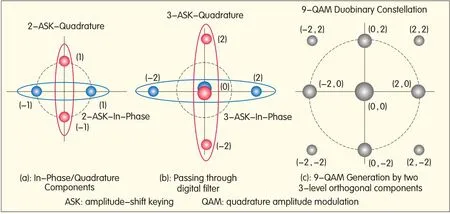
▲Figure 5.9-QAMsignal generated by a digital filter.
3 The 54.2 GBaud Signals on 50 GHz Optical Grid
This field experiment was conducted to investigate the feasibility of higher baud rate on the 50 GHz optical grid and with the same PDM-QPSKformat.QPSK constellations provide lower implementation penalty and the best trade-off between SEand distance compared with 16-QAM or higher-level QAM formats.Recent experiments have been done on hybrid transmission of asymmetrically interleaved 224 Gbit/s and 112 Gbit/s PDM-QPSK channels at 3 bit/s/Hz.The filtering penalty is balanced between interleaved channels,and transmission distance of 2000 km can be realized by using Raman amplifiers and LEAFfiber[41]-[44].In this work,50 GHz grid Nyquist-WDM signals consisting of 8×216.8 Gbit/s PDM-CSRZ-QPSK channels are generated and transmitted with an unprecedented net SEof 4 bits/s/Hz.
The transmission link in Deutsche Telekom's optical network consists of 8 nodes from Darmstadt to Nurnberg with standard G.652 fiber[45].The highest and lowest span losses are 20 d B and 24.1 d B,respectively.In order to extend the transmission distance,additional 8×100k G.652 fiber spans are inserted in Stuttgart to increase the total distance to 1750 km.Commercial gain-flatten inline EDFAs are used so that fiber span loss can be compensated for without the need for additional gain equalizers in the link.The average loss of the 22 fiber spans is 21.6 d B.The test center,where both the transmitters and receivers were installed,was located at the Deutsche Telekom research center in Darmstadt.
Fig.8 shows the experimental setup of 8×216.8 Gbit/s PDM-CSRZ-QPSKsignalgeneration and transmission over 1750 km G.652 fiber deployed in the field and in the laboratory.The 54.2 Gbaud binary electrical signals are generated from a 4:1 electrical mux after multiplexing four-channel 13.55 Gbit/s binary signals.Eight ECLs with a linewidth of less than 100 kHz,with neighboring wavelength spacing of 50 GHz,and with output power of 14.5 d Bm are divided into odd and even carriers.Each I/Q modulator is driven by two 54.2 Gbit/s pseudorandom binary sequence(PRBS)electrical signals with a word length of(213-1)×4.These modulators modulate the odd or even carriers.The 67%CSRZ pulse carver is realized by using a single-arm Mach-Zehnder intensity modulator(IM)that is driven by a 27.1 GHz sinusoidal RF signal and that is DC-biased at the null points.Each path is polarization multiplexed by the polarization multiplexer.This comprises a polarization beam splitter(PBS)to split signal,an optical delay line(DL1 and DL2)to provide a delay of more than 100 symbols,and a polarization beam combiner(PBC)to recombine the signal.The odd and even channels are spectrally filtered and combined using a programmable WSSwith 50 GHz fixed grid.The optical spectrum of the single-channel 54.2 Gbaud PDM-CSRZ-QPSK signal before and after 50 GHz grid WSS is shown in Fig.9.The spectrum shape at the high-frequency edge is significantly affected by the strong opticalfiltering.

▲Figure 7.Field-trial link configuration in DT's opticalinfrastructure.

▲Figure 6.Lab experimental measurement.

▲Figure 8.Experimentalsetup for generating and transmitting 8×216.8 Gbit/s PDM-CSRZ-QPSK over 1750 km fiber.Eye diagrams of PDM-CSRZ-QPSKbefore(a)and after(b)CSRZpulse curving.
The generated 8×216.8 Gbit/s PDM-CSRZ-QPSK signal is launched into a 22-span G.652 fiber transmission link(Fig.7).At the receiver,a tunable opticalfilter(TOF)with 3 d B bandwidth of 1 nm is used to select the desired channel to be further evaluated.An ECL with a linewidth of less than 100 kHz is used as the local oscillator(LO).
A polarization-diverse 90°hybrid is used for polarization-diverse and phase-diverse front end of the balanced coherent detection.Sampling and digitization(A/D)is performed in the digital scope with 80 GSa/s sampling rate and 30 GHz electrical analog bandwidth.DSPis performed offline.Electrical impairment equalization and polarization demultiplexing is performed using the following blind equalization steps:
Step 1:The clock is extracted using the square-and-filter method,and the digital signal is resampled at twice the baud rate of the recovery clock.
Step 2:AT/2-spaced time-domain finite impulse-response(FIR)filter is used to compensate for chromatic dispersion.The filter coefficients are calculated from a known fiber CD transfer function using the frequency-domain truncation method.
Step 3:Two complex-valued,13-tap,T/2-spaced adaptive FIR filter banks,found on a classic CMA,is used to demultiplex the QPSK signal and compensate for the residual CD and polarization-mode dispersion(PMD).LO frequency offset compensation and carrier-phase estimation(CPE)follow using Viterbi-Viterbialgorithm.As a result of linear equalization of the spectral shaping signals,the noise and linear crosstalk at the high-frequency edge of signals is enhanced,which leads to the OSNR reduction.
Step 4:Adigital postfilter,as discussed in section 2,is added and followed by the MLSEfor the partial response estimation.
Because of the known pattern of duobinary signaling,only two states with 1 bit memory length)are needed for the signal decoding of the independent electricallane.In this field experiment,errors are counted over 12×106bits(12 data sets,each data set contains 106bits),and differentialdecoding is used to solveπ/2 phase ambiguity.
Fig.10 shows the back-to-back BERas a function of OSNRwith noise measured at 0.1 nm bandwidth.We measure the performance of the middle channel at 1551.51 nm while temporarily turning off the adjacent
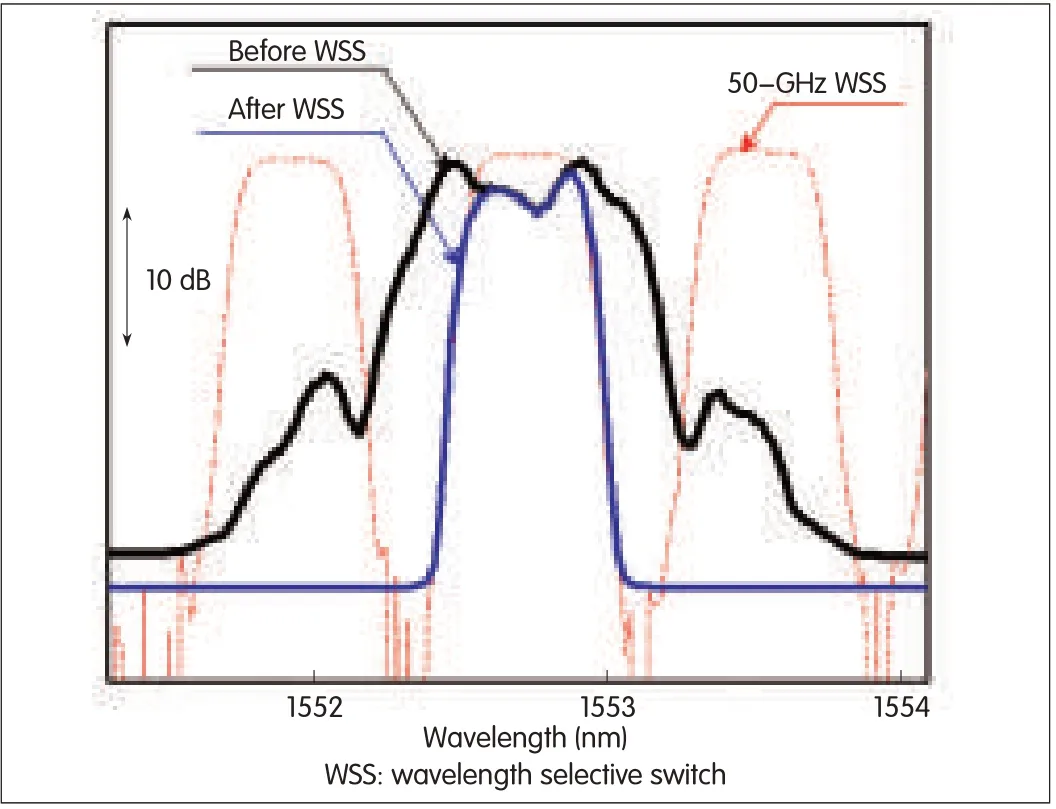
▲Figure 9.Spectrum before and after WSS(0.1 nm resolution).
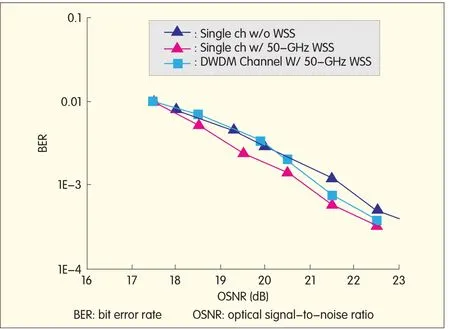
▲Figure 10.Back-to-back BERperformance of the middle channel at 1551.51 nm in differentsituations.

▲Figure 11.Opticalspectra(left)and BERperformance after transmission over 1750 km fiber.
Nyquist-WDM channels and bypassing the WSS.The required OSNRfor this single carrier at BER=1×10-3is 21.6 d B/0.1 nm.This corresponds to the theoretical implementation penalty.After 50 GHz WSSfiltering,a negative penalty of 0.8 d B is obtained.This penalty arises because the CS-RZ pulse has a very wide spectrum,and part of the optical power cannot be detected by the coherent receiver because of the limited bandwidth of the real-time oscilloscope[43].By turning on the adjacent carriers,the measured OSNRrequirement of BER=1×10-3for Nyquist WDM channels is about 21.4 d B.This means that a 0.6 d B penalty is caused by channel crosstalk.We also confirmed that all other channels perform similarly except that the side channel has 0.5 d B better OSNRtolerance.
The optical spectrum before and after transmission over 1750 km with 2 d Bm input power and 0.2 nm resolution is shown in Fig.11.The measured BERafter transmission,that is,the average of both Xand Ypolarizations,is also shown in Fig.11.The BERfor all Nyquist-WDM channels is better than the hard-decision(HD)pre-FEC threshold of 3.8×10-3.The average BERof all channels is 3.1×10-3,with individual BER values ranging from 2.1×10-3at the edge to 3.6×10-3in the middle channel.
Fig.12 shows the BERafter transmission when the signal power into each span fiber is varied.The input power at 2 d Bm per channel is the optimal launch power.The constellation diagrams of the transmitted signal before and after digital filtering are shown in Fig.12(insert).The binary QPSKsignal is converted into duo-binary QPSKsignal with less noise.The results from our field experimental show the potential for ultralong-haul transmission using the doubled baud rate and the relatively simple QPSK modulation format.
4 Mixed Transmission of 100G,400G,and 1 T
In a similar optical link,we conducted another field trial on the mixed transmission of 120G signals and two multicarrier superchannels at 448 Gbit/s and 1.3 Tbit/s(Fig.13).The 400G superchannel is generated using four independent ECLs with a linewidth of less than 100 kHz(Fig.14).The PRBS rate is 28 Gbit/s for four electrical lanes.After the polarization multiplexing structure for odd and even channels,the PDM-QPSKsignals pass through a WSS,which is programmed to operate at 25 GHz interleaving mode for spectral shaping of all input subchannels.This yields an SEof 4 bit/s/Hz.The generation of 13-subcarrier 1Tsignal is different.The CWlight from an ECL with a linewidth of less than 100 kHz and output power of 14.5 d Bm is modulated by a cascaded phase modulator(PM)and IM.The PM is driven by an RFclock at 25 GHz with a peak-to-peak voltage of 17 V.Its half-wave voltage and insertion loss is 4 Vand 3.8 d B,respectively.After phase modulation,multiple coherent carriers spaced at 25 GHz are generated.The
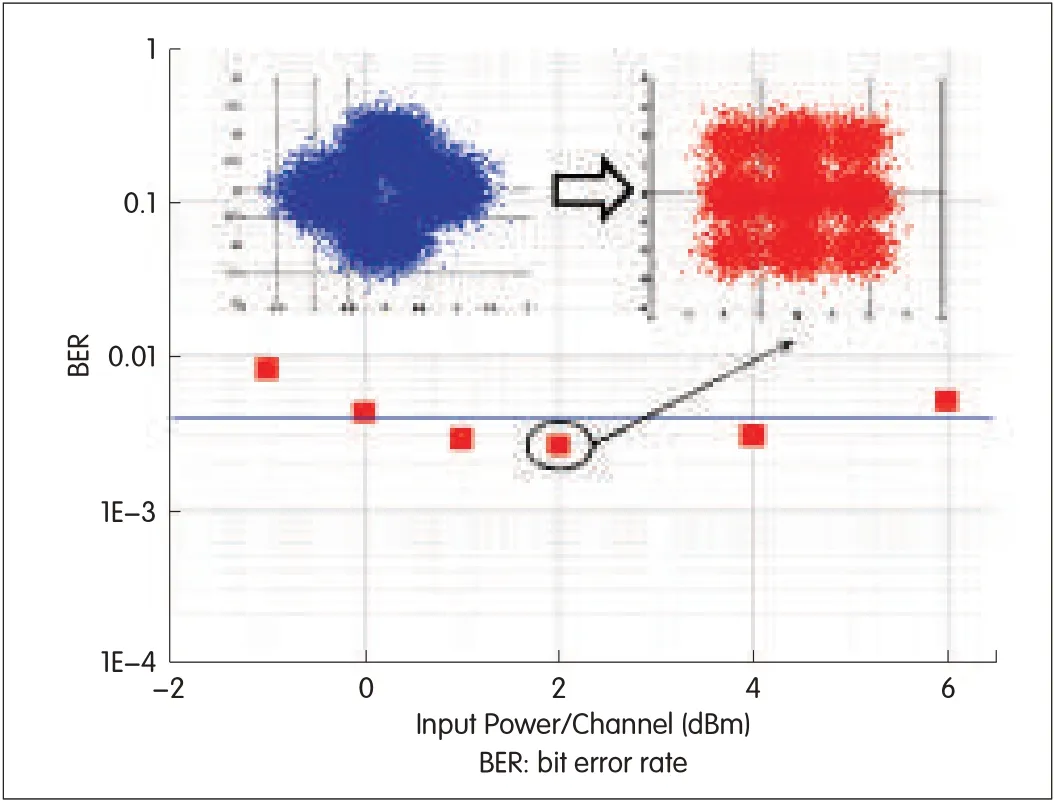
▲Figure 12.BERperformances after 1750 km transmission at different inputoptical power per channel.
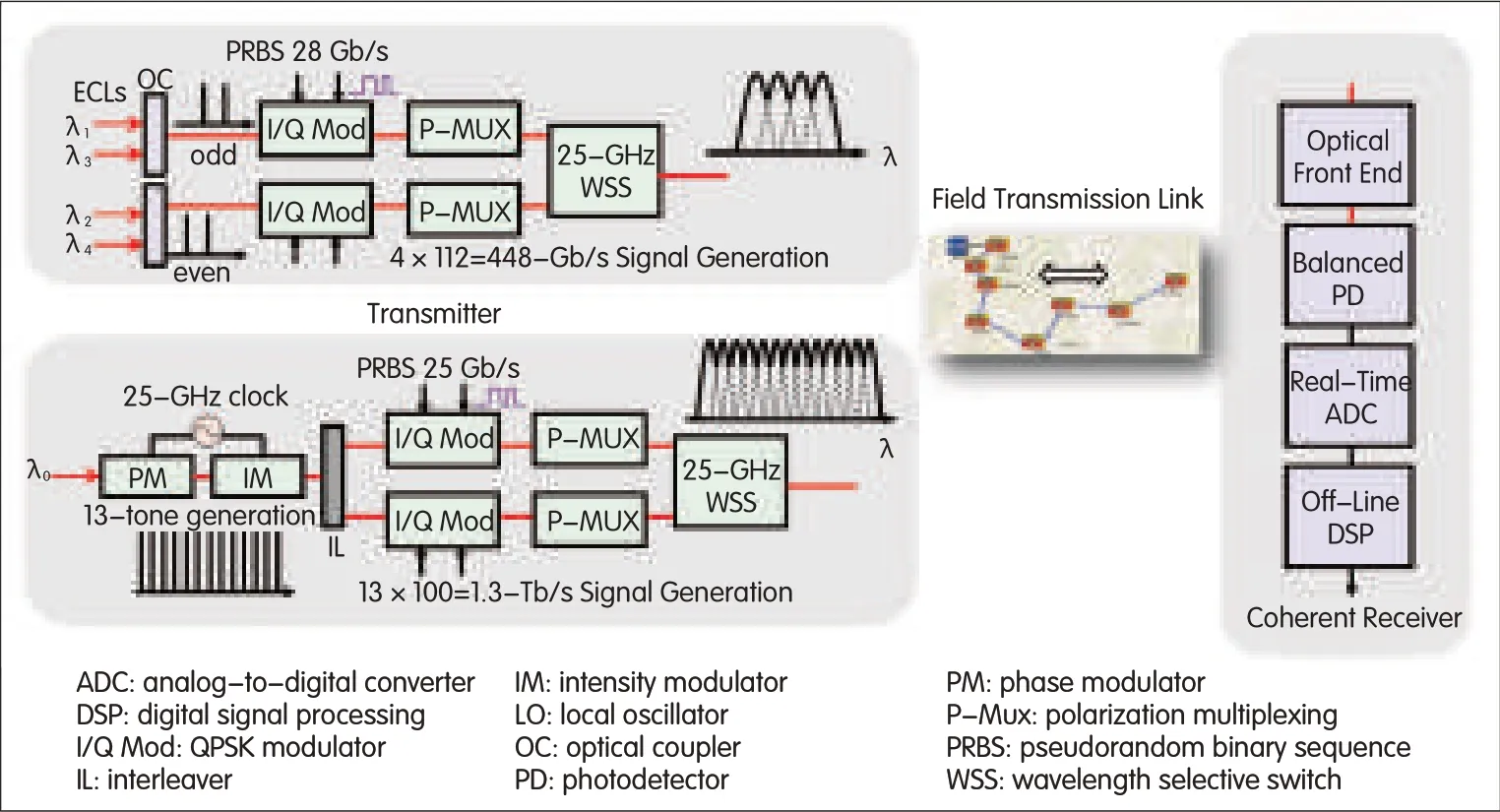
▲Figure 13.Differentgeneration schemes of 400Gand 1Twith similar coherentdetection.
following IM is driven by a synchronized 25 GHz clock and is used to flatten the optical subcarriers generated by the PM.Then,the odd and even channels are separated using a 25/50 GHz opticalinterleaver(IL).The odd and even channels are independently I/Q modulated by a 25 Gbit/s PRBSsignal and then polarization multiplexed.They are then combined by a 25 GHz WSS,which performs a similar function as in the 400G case.The signal occupies 325 GHz optical bandwidth.Significant linear crosstalk is expected to occur in the 400G and 1Tcases.The digital filter and MLSEthat follows are used to mitigate this impairment.The 100G line card used in this field experiment is a real-time coherent transceiver that is multisource agreement(MSA)package compliant.It consists of a 100GECFPat the client side,OTU4 framing,PDM-QPSK modulation at line side,and coherent detection and DSPat receiver side(Fig.14).A 40 nm CMOSASICis used with a four 8 bit,63 GSa/s ADC on the receiver side.One of the key features of the MSA transceiver is that it has SD-FEC capability for correcting a pre-FECBERof 1.9e-2 to less than 1e-15,which corresponds to an 11.1 d B net coding gain.The total line rate is 120 Gbit/s with 15%SD-FEC overhead,which is based on Turbo-Product Code(TPC).Fig.15(a)and(b)shows the back-to-back BERmeasurements as a function of OSNRfor the 400G and 1TQPSK subchannel,respectively.The black square represents the performance of a single subcarrier without spectral shaping by the WSS.The subcarrier in 400G has 1.5 d B penalty at BER=1×10-3,and the subcarrier in 1Thas 1.4 d B penalty at the same BER.The difference in receiver sensitivity can be attributed to the 25 GHz spectral shaping of 25 Gbaud and 28 Gbaud signals.No substantialerror floor is observed for both cases.Fig.16(a)shows back-to-back pre-FEC BERas a function of OSNRfor a 100G channel.Atheoretical curve is also shown for comparison.OSNRof 15.5 d B is required for BER=1×10-3,and only 1 d B implementation penalty is generated from the theoretical limit at SD-FEC threshold.The 400G and 1Tchannels co-propagate with two 100G signals.The spectrum of the mixed signals after 1750 km transmission is shown in Fig.16(b).The field experiment results are obtained for a launch power of 400G and 1Tof-2 d Bm per channel.The optimized launched power is-2 d Bm and-1 d Bm for 400G and 1Tper channel,respectively.The average received OSNRis 17.5 d B.The two 100G channels are located at 1558.85 nm and 1557.25 nm.Fig.17 shows constellation diagrams and the corresponding measured BERafter 1750 km transmission for both 400G and 1Tsignals.Fig.18 shows BERas a function of the transmission distance in mixed-channel operation.Transmission distances of 950 km(all field fiber),1750 km(950 km field+800 km lab fiber in Stuttgart),and 2150 km(950 km field+800 km lab fiber in Stuttgart+400 km lab fiber in Darmstadt)are measured with the BERperformance better than pre-SD-FEC threshold.After 2150 km transmission,the pre-FEC BERis 7.7×10-3and 5.7×10-3,respectively.This means that the encoding correction should be in the SD-FEC region.In the case of 100G transmission,a BERof 5.6×10-4is achieved after 2150 km transmission.We also measured the transmission performance over 2450 km,the longest distance obtainable in our field trialwith two 100G channels alone.Alarge BER margin still exists,even when pre-HD-FEC threshold and error-free transmission is verified on the client side.
5 Conclusion
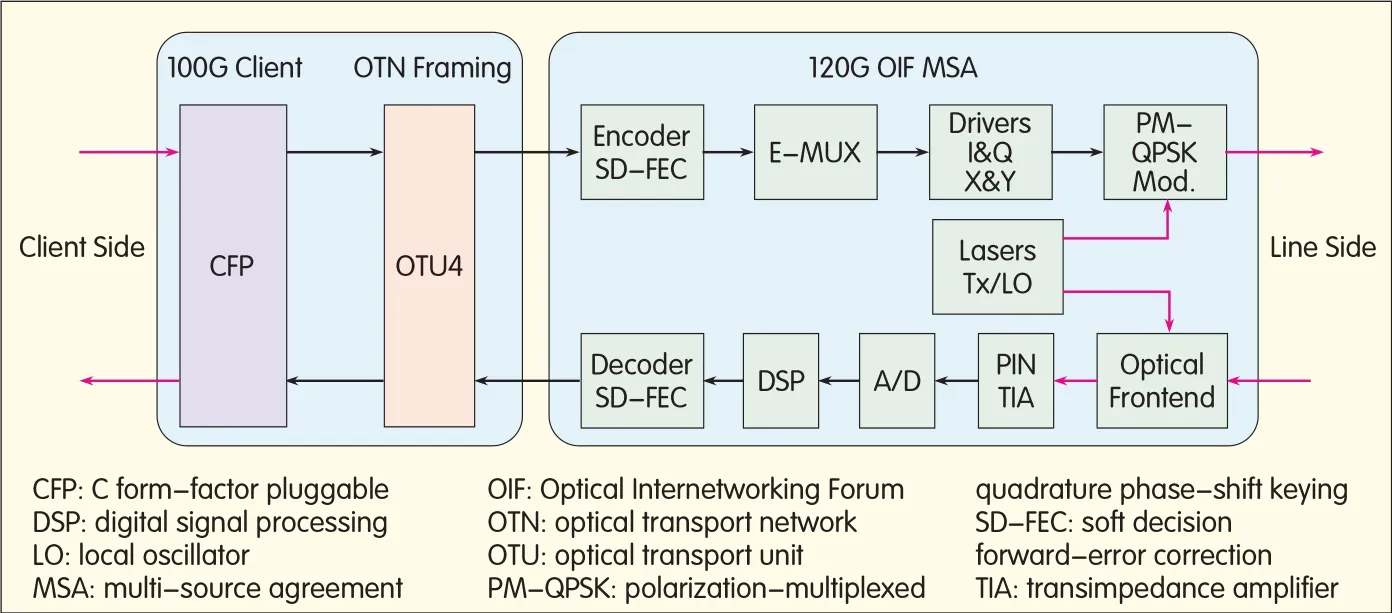
▲Figure 14.100GMSAtransceiver with SD-FECcapability.
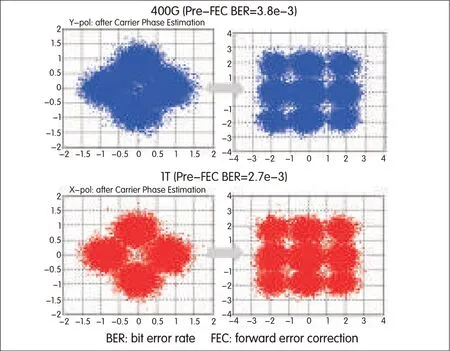
▲Figure 17.Constellation diagrams after 1750 km transmission.
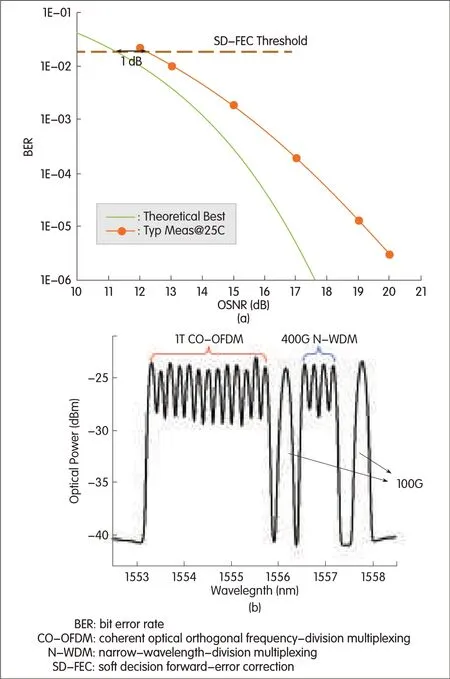
▲Figure 16.(a)Measured back-to-back pre-FECBERperformance versus OSNRof the 100Gchannel,and(b)optical spectrum of a mixture of two 100Gchannels,one 400G,and a 1Tchannelafter 1750 km transmission.
In our field trial,we successfully demonstrated the transmission of 100G and beyond over Deutsche Telecom's optical infrastructure.The first field experiment with 8×216.8 Gbit/s DWDM PDM-CSRZ-QPSK signals reached a record net SEof 4 bit/s/Hz over 22 SSMFspans with a total distance of 1750 km and with the BERof all channels smaller than the HD pre-FEC limit.This field experiment indicates that doubling the baud rate on the same 50 GHz grid with the same QPSK modulation is feasible to increase the capacity over long-haul transmission distances.In the case of mixed transmission,the 448 Gbit/s channel using Nyquist-WDM technology with PDM-QPSK modulation at each subcarrier achieved a net SEof 4 bit/s/Hz.Technology for generating multiple optical tones is used for the 1.3 Tbit/s superchannel creation with the same 25 GHz Nyquist spectral shaping and 325 GHz optical occupancy.These two superchannels—together with two neighboring real-time,SD-FEC based,100G coherent transceivers—are successfully transmitted over 1750 km optical link for pre-HD-FEC and 2150 km for pre-SD-FEC threshold with EDFA-only amplification in the link.The digitalpost filter and simplified MLSEalgorithm are introduced in beyond-100G channels to mitigate the enhanced noise and crosstalk caused by strong spectral shaping.For the 100G transponder deployed in the real network,a large BERmargin exists with respect to the pre-SD-FEC BERthreshold after transmission over 2450 km field fiber.These field experiments show that 100G technology with SD-FEC is capable of ultralong-haul transmission.Nyquist WDM with special signal processing is practically implementable and very promising for scaling channel capacity beyond 100G over longhaul distances.

▲Figure 15.Back-to-back receiver sensitivity of Nyquist(a)400Gand(b)1Tsignals.
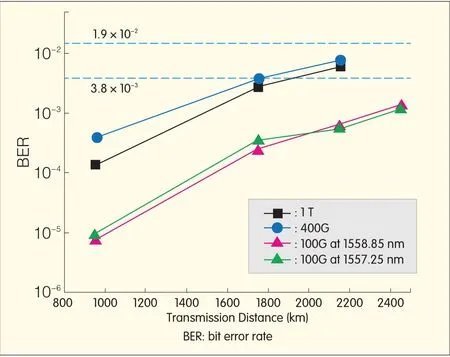
▲Figure 18.Transmission performance of 400Gand 1Tbased on Nyquisttechnique.
Acknowledgment
The author would like to thank Matthias Gunkel,Paul Wagner,Heinz Mayer and Achim Schippel from Deutsche Telecom for supporting the field transmission link;thank Yi Hong,Meng Li,Zhiliang Ren,Nan Lu,Li Xie,Kai Liu,Xiaochao Zhang,Yan Xia,and Yao Caifrom ZTECorporation,Beijing,for their dedicated technical support,and thank Dr.Jianqiang Lifor fruitful discussions.
- ZTE Communications的其它文章
- Introduction to ZTECommunications
- ZTEWins Contract to Provide LTEWireless Uifi Set to UNE
- ZTEPartners with KPNGroup Belgium to Deploy Packet-Switched Core Network
- Multiple-Constraint-Aware RWA Algorithms Based on a Comprehensive Evaluation Model:Usein Wavelength-Switched Optical Networks
- Mobile Cloud for Personalized Any-Media Services
- Open Augmented Reality Standards:Current Activities in Standards-Development Organizations

